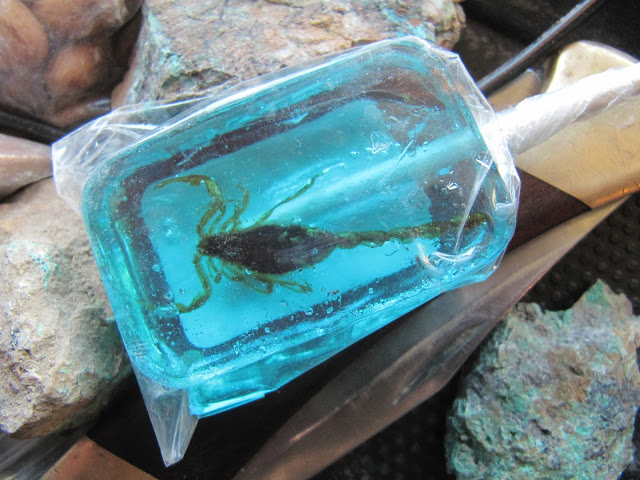The CR Briggs Gold mine is located in Death Valley, California. They are mining a gold ore which contains .001-.02 oz./ton of metal. Industry standards and the current price of gold dictate whether this is worth mining. The ore is a sulfide type, which means that there isn't free or native gold in the rock, instead it is locked away in sulfide minerals like pyrite. It is found here because a fault that originated due to the extension of California away from the American plate provided a pathway for gold-bearing fluids to come up. A cyanide leaching process is used to remove the gold from the sulfide minerals.
Overlooking the open pit gold mine. Our guide, William Stanley describes exactly what is going on. The trucks constantly run from the crusher, tailings pile and the bottom of the pit. The dump trucks get directed after they get filled, if they are full of good gold-bearing ore, they go to the crusher. If not, they go to a tailings pile which is saved to fill back in the pit after they are done working. Because there is so much activity, we could only watch from the top at this point.
Soon enough, a loud buzzer was heard and the pit was cleared for us to drive to the bottom and see the ores.
The two drill rigs to the right side of the picture are there to drill holes for explosives. About every two to three days they blast these explosives, exposing more ore, and making the pit deeper. Interestingly enough, they had to take into consideration their dust from the blast and how it might affect migrating birds when proposing their operation to the EPA.
Geologist John Kinney stands next to a vein of rich ore down at the bottom of the pit.
Our Suburbans were hardly as high as the tires on these dump trucks. Our guide told us that these were even the smaller variety of trucks, and that the larger kind could fit this dump truck into its bed. They take the gold ore to the crusher, which makes it all into .25" or smaller. This crushed rock is placed onto the leach pad, where sprinklers and drip lines that distribute the cyanide solution keep the heap producing gold.
This is the water that comes out of the Cyanide heap. It is rich in both cyanide which is now bonded with gold molecules. The netting sits over the water to prevent wildlife from accessing the water. As you can imagine, water is rare in Death Valley and so they have quite the variety of wildlife that attempts to get in. Every so often they get tasked with saving a bird from being stuck underneath the netting.
This water is treated by this small building, wrapped in extra barbed wire and secured with several cameras. They bring the water up through activated carbon filters, which precipitate the gold out. This gold is then taken from the carbon using acids and re-precipitated out to produce an ingot of gold and silver. They don't bother to separate the two, they just sell the whole ingot to the refinery. The cyanide leach pit will continue to produce gold for up to 10 or 15 years after the actual mining of material has ceased.














































